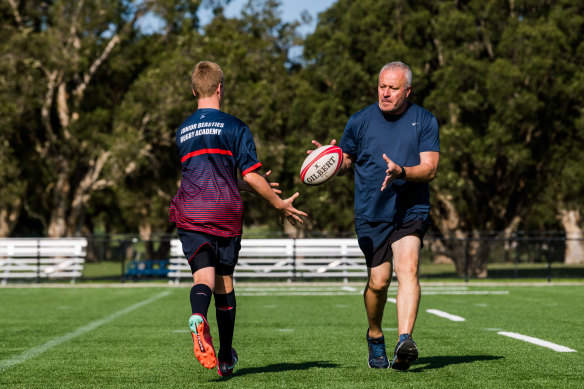Out of joint: Medicare shift urged as knee replacement rate soars

Thomas Mitsios bears the scars of a lifetime of rugby, boxing and muay thai. He bears them on both his knees, where they cover artificial joints.
The replacement knees have changed his life for the better. But he has regrets. He says that if he had known how to care for his joints, how to exercise without hurting them, he could have prevented the surgery.
Thomas Mitsios with son Maxim at Easts Rugby training in Rose Bay on Monday.Credit:James Brickwood
“Instead of telling me what to do, my GP would just say, ‘Here are some painkillers. Bye.’”
As the federal government prepares for major changes to Medicare, Australia’s soaring rate of knee replacement surgery offers a case study about how the system prioritises surgery and medication over prevention.
Researchers, allied health professionals and even surgeons say the system needs to change.
Many of the knee surgeries former Knee Society president Christopher Vertullo performs every day could have been avoided with proper preventive care, he says.
He has spent years lobbying governments to invest in knee injury prevention programs, to no effect. “I personally find that very frustrating,” he says.
Australia has one of the highest rates of knee replacement in the world. Even accounting for our ageing population, that rate has doubled since 2002.
The problem is that Medicare tends to fund surgery and drugs, rather than preventive programs such as exercise, says La Trobe University’s Professor Hal Swerissen, who has written a report on chronic disease prevention.
“GPs are generally pretty poor at prevention because the system is not set up to encourage them to focus on prevention,” says Swerissen.
Two procedures demonstrate this.
In 2010, Medicare slashed the rebate for sports and exercise physicians by 30 per cent. It was the only group to see such a cut, says University of Sydney Adjunct Professor John Orchard, who is also a sports physician.
The cut was despite evidence showing physiotherapy-led rehab for knee osteoarthritis cuts pain and improves quality of life.
Meanwhile, surgical clean-ups of the knee are extremely popular, despite strong evidence showing they do not work. Mitsios had one, and describes it as a “waste of time and money”. The procedures remain funded by Medicare.
“It shouldn’t be a surprise that if we provide bad treatments in the public system … that we will get bad outcomes, and that is exactly what we get,” says Orchard.
Under Medicare rules, patients are entitled to only five subsidised sessions a year with an allied health provider – such as a physiotherapist or dietician. Medicare does not cover exercise programs.
A knee replacement might cost the taxpayer $25,000. “But we wouldn’t spend $1000 on an exercise program to prevent that from happening,” says Australian Physiotherapy Association national president Scott Willis.
On Friday, the government released the Strengthening Medicare Taskforce’s report, which calls for an expansion of multidisciplinary care to deal with chronic diseases.
The report recommends funding doctors to work together with physios and other specialists to care for a patient.
Medicare was designed in the 1960s, when only doctors and dentists were university educated, says taskforce member Professor Stephen Duckett.
“That world has changed,” he says. “We’ve got highly skilled health professions other than doctors and dentists. We have a population with extensive morbidities. We need to use the skills of everyone we’ve got, and Medicare needs to be updated to allow that more easily.”
For patients with early signs of knee osteoarthritis, mixed care might involve a visit to a dietitian to manage their weight – a key risk factor for knee replacements. A middle-aged woman with severe obesity is more than 17 times more likely to need a knee replacement than a woman of normal weight.
Visits to a physio could also be funded to work on an exercise program.
“We know what needs to be done,” says Professor Ilana Ackerman, co-deputy director of the musculoskeletal health unit at Monash University. “The health system needs to prioritise these services and fund them appropriately.”
Mitsios missed the opportunity to use those programs. But for his knee rehab he now sees an exercise physiologist, who has him swimming and cycling – low-impact exercises that take the load off the knee.
“If I had known, I would have done this earlier,” he says.
Liam Mannix’s Examine newsletter explains and analyses science with a rigorous focus on the evidence. Sign up to get it each week.
Most Viewed in National
From our partners
Source: Read Full Article

